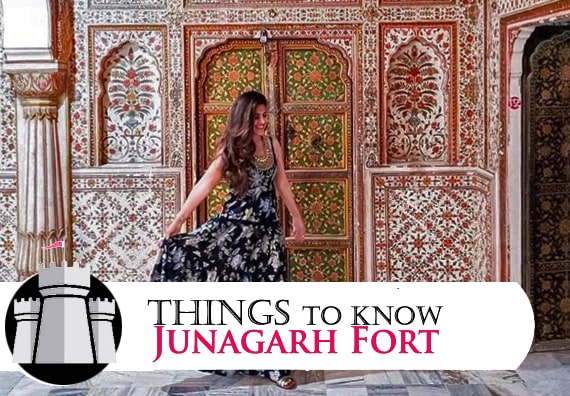Junagarh Fort is renowned as one of India’s most magnificent forts, showcasing opulent palaces that provide a glimpse into the lives of Bikaner’s maharajas.
Constructed by Raja Rai Singh in 1588 AD, the fort complex includes palaces, courtyards, pavilions, and balconies. Unlike many forts in Rajasthan, Junagarh Fort is not built on a high rock, featuring lower ramparts and towers that highlight its emphasis on luxury rather than defense.
Junagarh Fort is a treasure trove of history and artistry, offering a captivating journey into Rajasthan’s royal heritage. Its walls and palaces are adorned with carved stones, marble, paintings, and inlaid semi-precious stones, each reflecting the unique styles of different rulers across centuries.
The fortified complex houses numerous beautiful palaces, reflecting the diverse rulers who once resided here. Historians consider Junagarh Fort a living museum of arts, showcasing Indo-Mughal architecture with red sandstone sourced from Jaisalmer. Junagarh Fort is one of the key destinations in Rajasthan travel packages.
- Architectural Layout of Junagarh Fort
The Junagarh Fort complex has two entrances and features a total of 986 long walls with 37 bastions. Within its walls are 37 palaces, numerous pavilions, and temples. A notable aspect of Junagarh Fort’s architecture is its exquisite stone carving, showcasing exceptional quality. Many rooms in the palace are adorned with paintings and decorations done in traditional styles.
The main gates of the fort are Suraj Pol (Sun Gate) and Daulat Pol. Suraj Pol faces east and serves as the primary entrance, while Daulat Pol bears the handprints of royal ladies who committed sati alongside their deceased husbands at the Sati Stambh. Other inner gates include Chand Pol, Karan Pol, and Fateh Pol.
Anup Mahal boasts exquisite usta work in Mughal style, while Badal Mahal‘s blue walls painted with white clouds were designed to please Maharaja Sardar Singh, known for his love of music.
- Best Time to Visit Junagarh Fort
The best time to visit Junagarh Fort is during the winter months, between November and February. During this time, the weather is cooler and more pleasant, making it ideal for exploring the fort, its palaces, and the surrounding areas at leisure. Temperatures typically range from 4°C (39°F) to 23°C (73°F) during this season. Since nights can be chilly, it’s advisable to carry jackets and woolen accessories for added comfort.
Junagarh Fort, originally named Chintamani and built by Raja Rai Singh Ji between 1589 and 1593, earned its current name after the Royal family relocated their residence to Lalgarh Palace. Standing since 1594, this fort is a symbol of royal culture and remarkable architecture. Over the centuries and under the reign of various kings, numerous additions were made, leading to the creation of palaces, museums, temples, and gardens within its premises.
- What to see in fort
At the entrance, you can see the Sati Handprints, left by women who immolated themselves on their husbands’ funeral pyres, showing their devotion. The fort’s exquisite doors are crafted from walnut wood imported from Kashmir, featuring stunning carvings. Additionally, a notable sight is the large silver door weighing 65 kg, located in the courtyard after Karan Mahal.
So don’t miss visiting it during your Rajasthan trip package.
- Karan Mahal
Karan Mahal, also known as the Public Audience Hall, was planned during the reign of Maharaja Karan Singhji and constructed under Maharaja Anup Singhji in honor of his father. It stands as a prime example of Mughal-style architecture, showcasing extensive use of white marble.
- Phool Mahal
Phool Mahal, the oldest part of the fort, was built under Raja Rai Singhji. The decorations and artwork in this section draw inspiration from the Jahangirian period.
- Anup Mahal
Anup Mahal, or the Private Council Hall, was constructed by Maharaja Anup Singh. This hall features a central throne used by the Maharaja to meet high officials and foreign visitors. The throne is adorned with intricate golden work and mirrors, enhanced by vibrant colors like green, violet, and purple, creating a captivating ambiance.
- Badal Mahal
Badal Mahal, named for its depiction of rain, showcases blue and white cloud motifs on its roof, symbolizing the importance of rain in the arid land.
- Gaj Mandir
Gaj Mandir, built by Maharaja Gaj Singhji along with his two favorite queens, is characterized by its lavishness and architectural beauty. The hall boasts intricate floral artwork and the use of marble, creating a fairy-tale atmosphere within its walls.
- Dungar Niwas
Dungar Niwas, commissioned by Maharaja Dungar Singhji, known for modernizing Bikaner, stands out for its architectural finesse and artistic details. What sets it apart is the introduction of a lift, marking Bikaner’s transition to electricity in 1886.
- Durbar Hall
Durbar Hall, also called Ganga Durbar Hall, was constructed by Maharaja Ganga Singh. Its beautiful pink walls showcase weapons and protective attire from wartime. The hall houses an heirloom, the sandalwood throne, believed to have been brought to Bikaner by Rao Bikaji, the elder son from Jodhpur’s Mehrangarh fort, after Rao Jodha ji’s demise.
- Vikram Villas
Vikram Villas features war memorabilia, palkis (sedan chairs), awards, a throne, and a centerpiece: a WWI De Havilland DH-9 biplane bomber.
- Hawa Mahal Palace
The Hawa Mahal Palace, situated on the top floor for cool summer winds, and the Gaj Mandir Palace, showcasing marvelous marble inlay work, are highlights. Inspired by European palaces, the Vikram Vilas Palace served as the Darbar Hall for royal court proceedings.
Don’t miss the DH9 De Havilland warplane, a recognition of the Bikaner State Forces’ contribution during World War I.
Kote Gate serves as the main entrance to the city, bustling with tourists shopping for Rajasthani art and craft items throughout the day.
Bikaner is renowned not only for shopping but also for its culinary delights. Local delicacies like Mirchi Pakora, Jalebi, and Ghewar can be savored at M.G Road.
- Travel Tip:
opt for local transportation within Bikaner as heavy traffic makes driving challenging for outsiders.
- To reach Junagarh Fort:
By Road : Bikaner is well-connected by road to major cities like Delhi (458km), Jaipur (354 km), Jodhpur (235 km), and Jaisalmer (333 km). Regular government and private bus services operate to these cities.
By Train : Bikaner railway station is well-connected to Delhi, Kolkata, Agra, Jaipur, and Allahabad. Don’t delay; visit our office today to secure one of finest Rajasthan holiday package from Kolkata!
By Air : The nearest airport to Bikaner is Jodhpur Airport, located 235 km away.
Visiting Hours : 10am-4:30pm
Entry Fees: (all in INR)
- 50 per person for Indians
- 300 per person for Foreigners
- 30 per person for Indian students
- 150 per person for foreigner students

